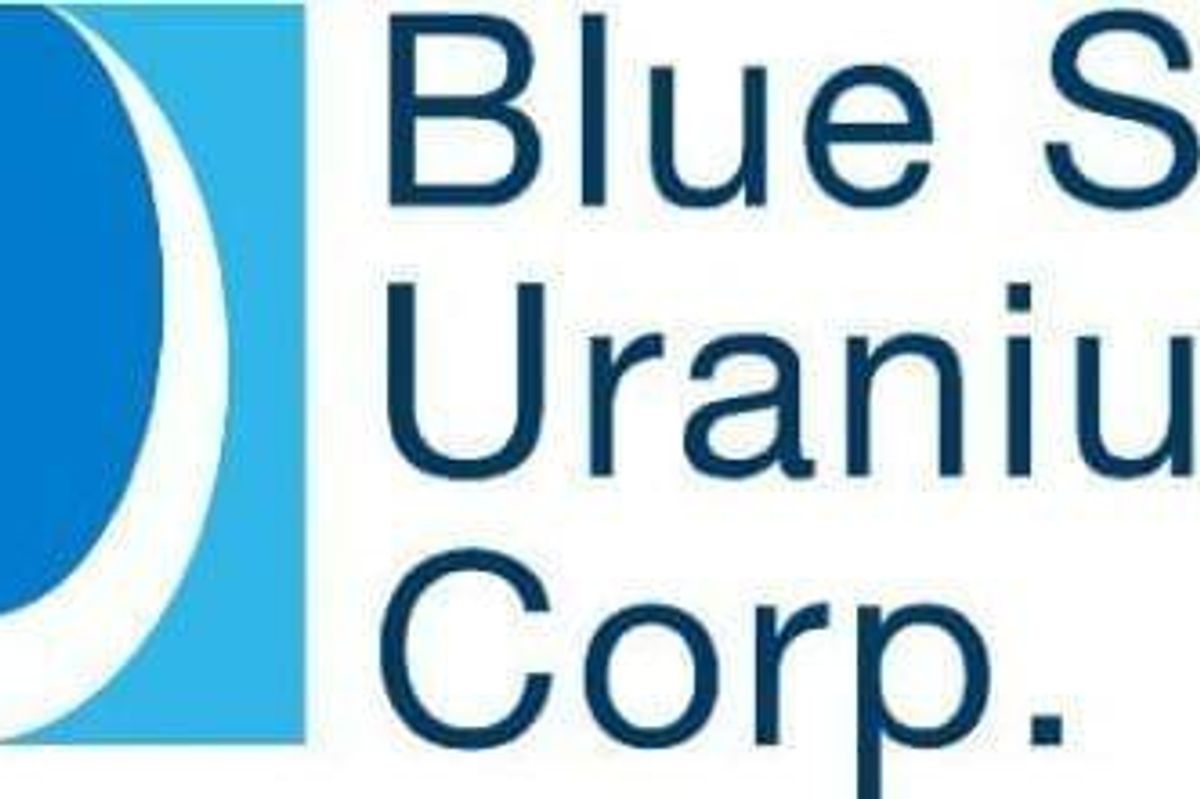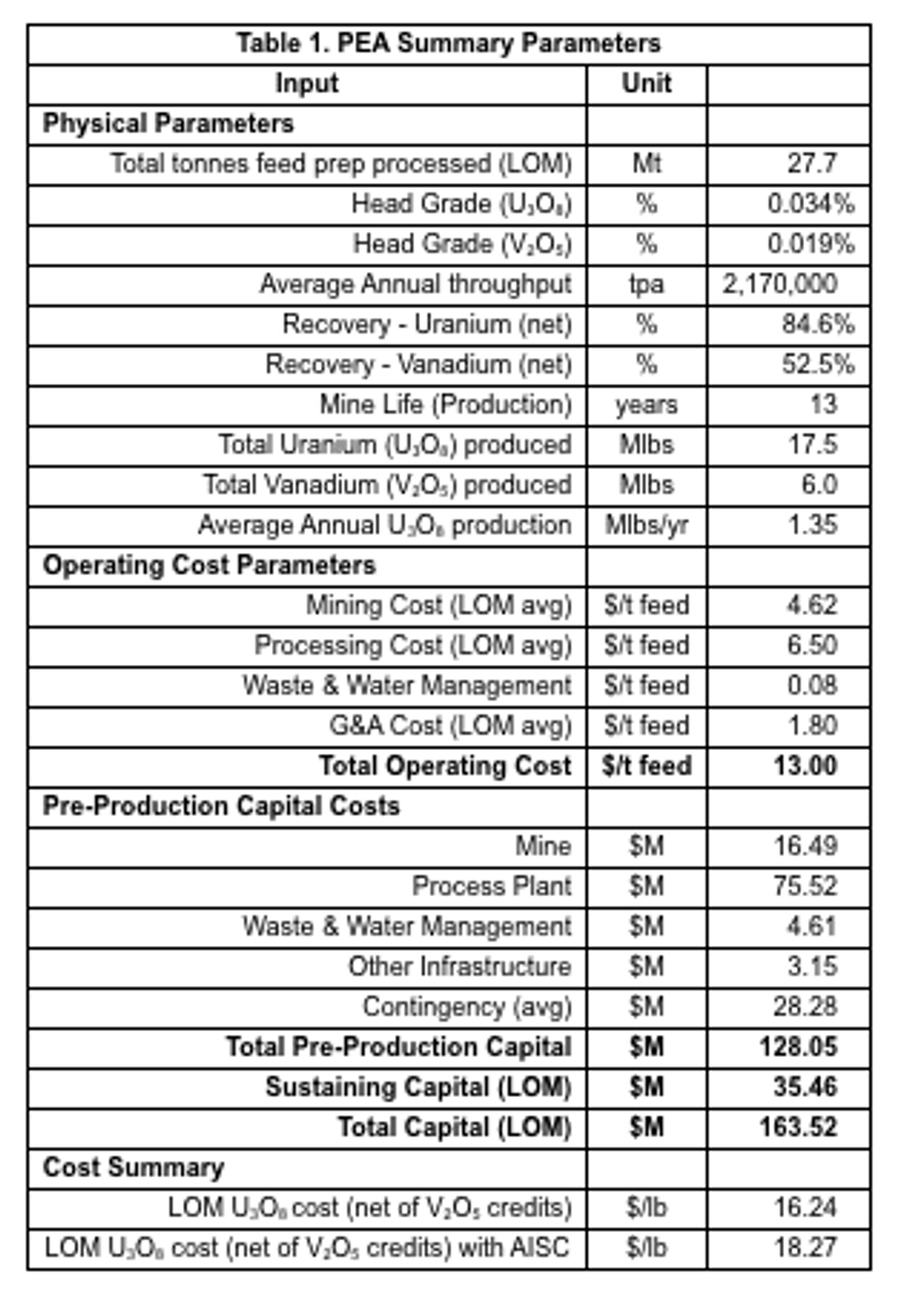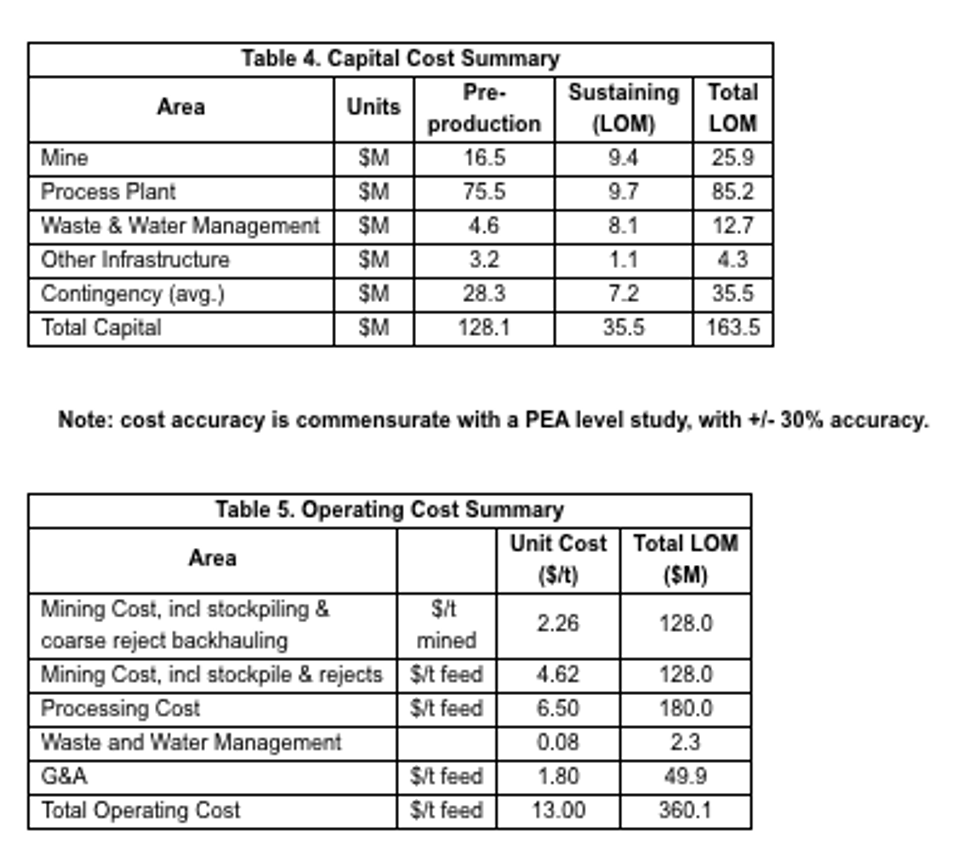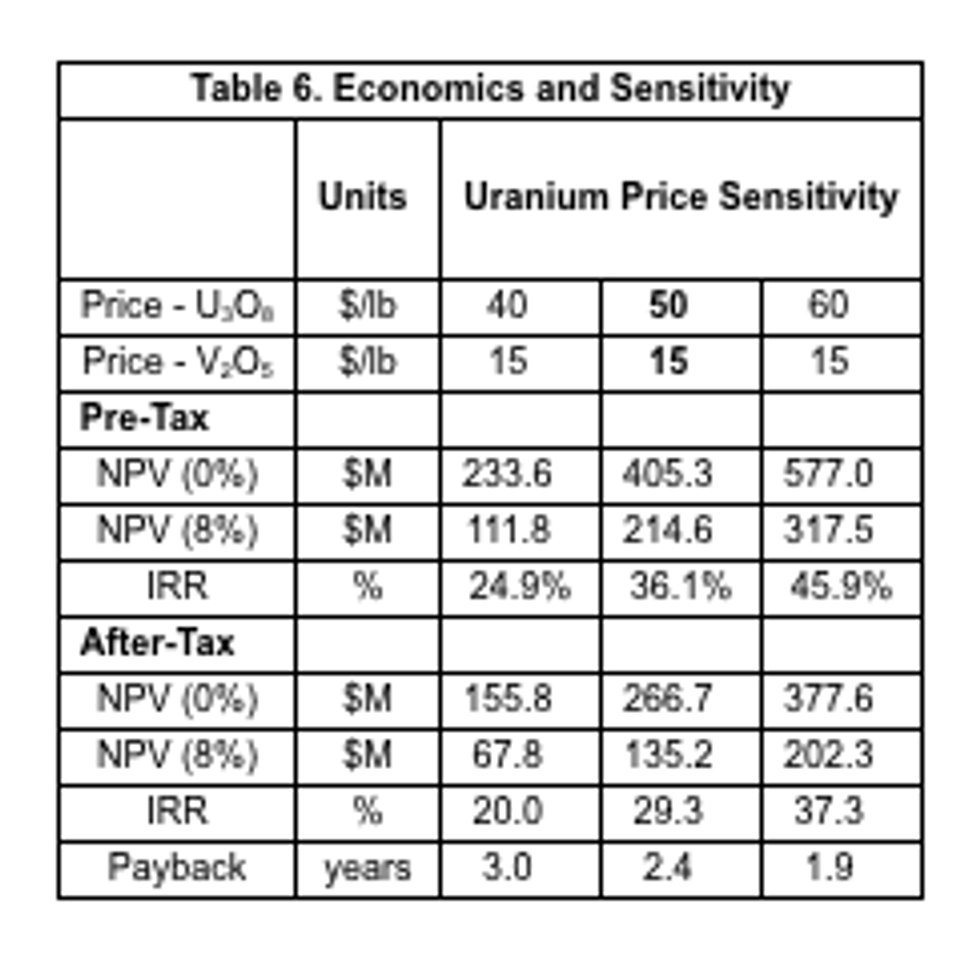Blue Sky Uranium Announces a Positive Preliminary Economic Assessment for the Ivana Uranium-Vanadium Deposit, Amarillo Grande Project, Argentina

Blue Sky Uranium (TSXV:BSK; OTC:BKUCF) (“Blue Sky” or the “Company”) is pleased to announce the results of the first Preliminary Economic Assessment (“PEA”) for the Ivana Uranium-Vanadium deposit at the Company’s 100% owned Amarillo Grande Project in Rio Negro Province, Argentina.
Blue Sky Uranium (TSXV:BSK; OTC:BKUCF) (“Blue Sky” or the “Company”) is pleased to announce the results of the first Preliminary Economic Assessment (“PEA”) for the Ivana Uranium-Vanadium deposit at the Company’s 100% owned Amarillo Grande Project in Rio Negro Province, Argentina. The PEA demonstrates robust economics for a surficial mining operation of the Ivana deposit, with 13 years of uranium and vanadium production.
PEA Highlights (All figures in US dollars)
- After-tax NPV8%: $135.2 million
- After-tax IRR: 29.3%
- After-tax Payback period: 2.4 years
- Pre-production Capital Cost: $128.05 million, includes $28.28 million contingency
- Life of mine (“LOM”) Sustaining Capital Cost: $35.46 million, includes $7.21 million contingency
- Average LOM Total Cash Cost net of credits: $16.24/lb U3O8
- Average LOM All-In Sustaining Costs (“AISC”) net of credits: $18.27/lb U3O8
PEA Key Assumptions & Inputs
- Uranium price: $50/lb U3O8
- Vanadium Price $15/lb V2O5
- Years of Construction: 2
- Years of Production: 13
- Strip Ratio: 1.1:1 (waste/ore)
- Dilution: 3%
- Peak Mining rate (waste + mill feed): 13,500 tonnes per day (“tpd”)
- Processing throughput: 6,400 tpd
- Process Plant Recoveries, Uranium: 84.6%
- Process Plant Recoveries, Vanadium: 52.5%
- Average Annual Production (LOM): 1.35 Mlbs/y U3O8
- LOM uranium production: 17.5 Mlbs U3O8
“This PEA demonstrates that the Ivana deposit is a leading new low-cost uranium-vanadium development project,” stated Nikolaos Cacos, Blue Sky President & CEO. “With the expansion upside at Ivana and the discovery potential for new uranium and vanadium resources throughout the district-scale property, we expect Amarillo Grande to continue to improve its value proposition.”
Additional exploration work and detailed engineering studies are expected to expand and upgrade mineral resources, and further optimize and enhance the economics of the Ivana uranium-vanadium deposit.
PEA Summary
The PEA parameters are summarized in Table 1.
The PEA is preliminary in nature and is based solely on Inferred Mineral Resources that are considered too speculative geologically to have economic considerations applied to them that would enable them to be categorized as Mineral Reserves. Mineral Resources that are not Mineral Reserves do not have demonstrated economic viability and there is no certainty that the PEA will be realized.
Mineral Resource Estimate
An updated Mineral Resource Estimate, effective September 28th, 2018, was used for the PEA. Supporting information will be included in the NI 43-101 Technical Report to be published within 45 days of this press release. The updated resource estimate includes data from an additional 61 reverse circulation (“RC”) drill holes (1,043 metres) completed in September of 2018, as well as a more extensive density study that indicated a density of 2.1 gr/cm3 should be applied. Those changes resulted in a 17% increase in total tonnes, as well as a 19% increase in contained U308 and a 13% increase in contained V205, at similar grades.
The estimate of mineral resources may be materially affected by environmental, permitting, legal, title, taxation, sociopolitical, marketing, or other relevant issues. The quantity and grade of reported Inferred resources are uncertain in nature and there has been insufficient exploration to classify these inferred resources as Indicated or Measured, and it is uncertain if further exploration will result in upgrading them to an Indicated or Measured category.
| Notes to Table 1: | |
| 1. | Mineral Resources are not Mineral Reserves and do not have demonstrated economic viability. |
| 2. | It is reasonably expected that the majority of Inferred Mineral Resources could be upgraded to Indicated Mineral Resources with continued exploration. |
| 3. | The Mineral Resources in this estimate were not constrained within a conceptual pit shell owing to the shallow nature of the deposit (<25 m). |
| 4. | The 100 ppm uranium reporting cutoff grade is based on operative costs of $12/t, a price of $50/lb U3O8, and a process recovery of 90%. A density of 2.1gr/cm3 was applied. |
| 5. | The resource was estimated within distinct zones of elevated uranium concentration occurring within the host sediments. Vanadium is associated with uranium and is estimated within the same zones. There is no indication that Vanadium occurs outside of the elevated uranium zones in the Ivana deposit area in sufficient concentrations to justify developing estimation domains focused on Vanadium. |
Mine Plan
The Ivana operation will consist of surface mining operation delivering mill feed to a nearby processing plant or stockpiles. The annual mining rate will be approximately 4.7 Mtpa (13,000 tpd) consisting of waste material and mill feed. The average strip ratio is approximately 1.1:1.
Table 3 presents the potentially excavated tonnages. Mill feed may be delivered directly to the process plant or placed into stockpiles for blending purposes.
| Note: cut-off grade of 60 ppm U used to define potentially extractable portion of mineral resource |
The surface mine will be relatively shallow, with a maximum depth of 30 metres. The length of the mine will be approximately 3000 metres with widths ranging from 100 to 400 metres.
Mining will be done with a fleet of two (5 cubic metre) excavators, a front-end loader and six 31-tonne articulated trucks along with a fleet of support equipment. The materials mined are unconsolidated gravels and sands and are free digging, therefore drill and blast operations will not be required.
Waste materials will be placed out of pit for the first few years. Waste will then be placed either into external dumps or used as in-pit backfill.
Processing & Recovery
Mined mill feed may be delivered directly to the processing plant, or stockpiled. Stockpiles provide a surge capacity between the mining and processing, and enable blending, to manage the head grade of the process plant feed. Mill feed will then be processed in two stages. The overall process plant recovery is 85% for uranium (derived from 89% leach feed preparation recovery and 95% subsequent alkaline leach circuit recovery); and 53% for vanadium (derived from 89% leach feed preparation recovery and 60% subsequent alkaline leach circuit recovery). Recoveries were determined through the mineralogical, metallurgical and process engineering test work program completed by The Saskatchewan Research Council (SRC), as detailed in the Blue Sky press release dated February 7th, 2019.
Feed material will first be processed through the leach feed preparation plant, a semi-mobile screening and scrubbing facility located at the proposed mining site. The leach feed preparation plant will liberate fine material (<100 um) from the larger particles (>100 um) and scrub away and recover fine uranium and vanadium mineral particles coating the large particles, into a leach feed slurry. The rejected coarse fraction (approx. 75% of the mill feed mass from which most of the original uranium and vanadium has been stripped) will be dewatered, stockpiled, and backhauled by the mine fleet to the dump sites or backfilled into the mine excavation.
In the second process stage the slurry containing the fine fraction of the mineralized material will be pumped to the leach plant. An alkaline leach circuit (sodium carbonate and bicarbonate) will be used to dissolve uranium and vanadium from the leach feed minerals. No oxidant is required. Subsequently, uranium and vanadium will be separated by selective chemical precipitation, with uranium solids then calcined to U3O8 or UO3 and vanadium solids calcined to V205.
Tailings slurry from the alkaline leach circuit (approx. 25% of the mill feed mass and from which the majority of uranium and vanadium has been stripped) will initially be pumped to a surface tailings management facility (TMF) where it will settle and release water. This released water will be reclaimed and pumped to the water treatment circuit in the process plant where it will be further treated, resulting in solids that are pumped back to the TMF with the alkaline leach tailings. The final pH adjusted water will be returned to the process water tank for reuse. In later years, the fine tailings will be pumped into containment cells in mined out sections of the pit, for co-disposal with mine waste rock and coarse rejects. Long term storage of all waste material from mining operations will comply with all local and international regulations and requirements.
Infrastructure
The Ivana operation will take advantage of local infrastructure whenever possible. Employees will reside in local communities, most likely the town of Valcheta, approximately 25 km from the mine site. Grid power will be accessible to the project via the construction of a 30 km powerline. For the PEA it is assumed that process water will be supplied from on-site pumping wells. Ground water at the mine site is classified as non-potable for humans and animals but suitable for processing use. Future studies will further assess the local water resources.
Other site infrastructure will include maintenance shops, administration offices, a mine dry, diesel fuel storage, and warehouses.
Capital and Operating Costs
The life-of-mine capital and operating costs are summarized in Tables 4 and 5. The costs assume a fully owner-operated project. The closure and reclamation cost are estimated at $22.6 million and includes costs for site remediation and final backfilling of the remaining mine excavation.
Project Economics and Sensitivities
The economic results of the PEA are summarized in Table 6 on both a before-tax and after-tax basis. For the PEA Base Case a long-term uranium price of $50/lb U3O8 and a vanadium price of $15/lb V2O5 were used. Sensitivity to various uranium prices are shown in Table 6 while the vanadium price is kept fixed.
Uranium provides approximately 90% of the project’s revenue stream.
Opportunities
Infill drilling at the Ivana deposit is expected to upgrade the mineral resource from the Inferred category.
There is also potential to expand resources at Ivana, particularly to the west, where recent pit sampling returned significant intervals with high grades of uranium and vanadium (see Blue Sky news release dated November 15, 2018). Furthermore, there is excellent exploration potential in the area to the north of the Ivana deposit, and elsewhere on the Amarillo Grande Project concessions.
Additional improvements to the project economics are expected as more detailed engineering studies are undertaken and optimization studies are completed.
Future work on Ivana will include additional infill and step-out drilling to upgrade and expand mineral resources, as well as advanced engineering studies that will include a complete and comprehensive environmental base line study, additional metallurgical and process design test work, mine design optimization, detailed permitting assessment, among other items.
About the Amarillo Grande Project
The Company’s 100% owned Amarillo Grande Uranium-Vanadium Project in Rio Negro Province, Argentina is a new uranium district controlled by Blue Sky. The Project includes several major target areas over a regional trend, with uranium and vanadium mineralization in loosely consolidated sandstones and conglomerates, at or near surface. The area is flat-lying, semi-arid and accessible year-round, with nearby rail, power and port access.
The Ivana deposit is located in the southernmost of three target areas that comprise the Amarillo Grande Uranium-Vanadium project. Mineralization was first identified at Ivana after field follow-up of a 2010 regional high-resolution airborne radiometric and magnetic survey.
The Ivana deposit displays characteristics of both surficial-type and sandstone-type uranium-vanadium deposits. In plan view, the Ivana uranium-vanadium mineralization has a broad C-shaped pattern with some isolated outlying areas of peripheral mineralization. The uranium mineralization at Ivana is comprised of secondary uranium minerals which include carnotite, a coffinite-like mineral that has been called β-coffinite (beta-coffinite), as well as lesser tyuyamunite, leibigite, and an unidentified uranium-bearing mineral species.
Mineralization occurs within 25 m of surface in two stacked zones. The upper zone is comprised of predominantly carnotite mineralization, and the lower zone contains a mixture of mainly carnotite and β-coffinite mineralization. The two zones occur together through most of the deposit but there are localized areas where only one zone is present. The upper zone averages 2.7 m in thickness, with a maximum of 10 m, while the lower zone has a maximum of 20 m and has an average thickness of 6 m.
The Amarillo Grande project is believed to have district-scale potential for discovery of similar styles of mineralization.
QA/QC
The resource estimation was based on 488 RC drill holes, representing 7,622 metres of drilling with one metre samples. The drilling was completed in three phases starting in January 2017 and finishing in August 2018. Only 2 holes were inclined; the remainder were vertical. Bedding and mineralized horizons are approximately horizontal so vertical samples are believed to represent true thickness.
The drilling program was carried out using a Roc L8 and FlexiROC D65 drill rigs from Atlas Copco, ore-control track-mounted rigs adapted to RC with double and triple cyclone, respectively, to reduce the dust loss during sampling and automatic sampling. Samples were sent to Bureau Veritas Minerals of Mendoza, Argentina for preparation by drying, crushing to 80% passing 10 mesh and then pulverizing a 250g split to 95% passing 150 mesh. Pulps were sent to Bureau Veritas Commodities Canada Ltd. for analysis of 45 elements by means of Inductively Coupled Plasma Mass Spectrometry (ICP-MS) following a four-acid digestion (MA-200). Samples over 4,000ppm uranium are re-assayed, after phosphoric acid leach, by Inductively Coupled Plasma Electron Spectrometry (ICP-ES). After approximately every 10th sample a blank, duplicate, or standard sample was inserted into the sample sequence for quality assurance/quality control (QA/QC) purposes. The results of the QA/QC samples were reviewed by the Qualified Person. QA/QC sample performance confirmed sampling and assaying were of excellent quality allowing assay data to be used to estimate Inferred Resources.
Qualified Persons and NI 43-101 Disclosure
The results of the Company’s drilling program were reviewed, verified (including sampling, analytical and test data) and compiled by the Company’s geological staff under the supervision of David Terry, Ph.D., P.Geo. Dr. Terry is a Director of the Company and a Qualified Person (“QP”) as defined in National Instrument 43-101.
A National Instrument 43-101 (“NI 43-101”) Technical Report supporting the Mineral Resource Estimate and the Preliminary Economic Assessment will be filed on SEDAR within 45 days of this news release.
The Mineral Resource Estimate and associated information in this news release were prepared under the direction of Bruce Davis Ph.D., F.AusIMM, of BD Resource Consulting Inc. and Susan Lomas, P.Geo., of Lions Gate Geological Consulting Inc. Both Dr. Davis and Ms. Lomas are independent Qualified Persons (QP’s) as defined in NI 43-101.
The PEA and associated information in this news release were prepared under the direction of consultant Ken Kuchling, P.Eng., a mining engineer specializing in economic reviews and an independent Qualified Person as defined in NI 43-101.
Additional contributing Qualified Persons for the PEA are:
- Jon Thorson, Ph.D., CPG. (geological interpretation)
- Chuck Edwards, P.Eng. FCIM (metallurgy & processing)
- Ken Embree, P.Eng., of Knight Piésold Ltd (waste & water management)
All the QP’s have reviewed and approved the content of this news release.
About Blue Sky Uranium Corp.
Blue Sky Uranium Corp. is a leader in uranium discovery in Argentina. The Company’s objective is to deliver exceptional returns to shareholders by rapidly advancing a portfolio of surficial uranium deposits into low-cost producers. Blue Sky holds the exclusive right to over 434,000 hectares (equiv. to 1,072,437 acres) of property in two provinces in Argentina. The Company’s flagship Amarillo Grande Project was an in-house discovery of a new district that has the potential to be both a leading domestic supplier of uranium to the growing Argentine market and a new international market supplier. The Company is a member of the Grosso Group, a resource management group that has pioneered exploration in Argentina since 1993.
For additional details on the project and properties, please see the Company’s website: www.blueskyuranium.com
ON BEHALF OF THE BOARD
“Nikolaos Cacos”
______________________________________
Nikolaos Cacos, President, CEO and Director
Neither TSX Venture Exchange nor its Regulation Services Provider (as that term is defined in policies of the TSX Venture Exchange) accepts responsibility for the adequacy or accuracy of this release.
This news release may contain forward-looking statements including but not limited to comments regarding the timing and content of upcoming work programs, geological interpretations, receipt of property titles, potential mineral recovery processes, etc. Forward-looking statements address future events and conditions and therefore involve inherent risks and uncertainties. Actual results may differ materially from those currently anticipated in such statements. Readers are encouraged to refer to the Company’s public disclosure documents for a more detailed discussion of factors that may impact expected future results. The Company undertakes no obligation to publicly update or revise any forward-looking statements. We advise U.S. investors that the SEC’s mining guidelines strictly prohibit information of this type in documents filed with the SEC. U.S. investors are cautioned that mineral deposits on adjacent properties are not indicative of mineral deposits on our properties.
SOURCE Blue Sky Uranium Corp.

For further information: Corporate Communications, Tel: 1-604-687-1828, Toll-Free: 1-800-901-0058, Email: info@blueskyuranium.com
Related Links
Click here to connect with Blue Sky Uranium (TSXV:BSK; OTC:BKUCF) for an Investor Presentation.
Source: www.newswire.ca











